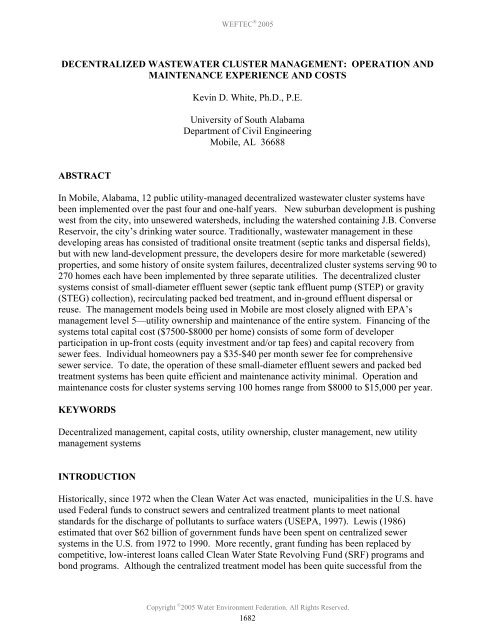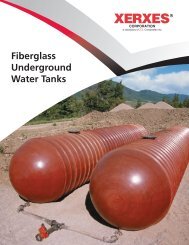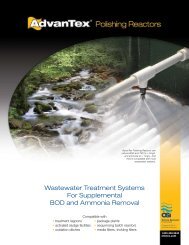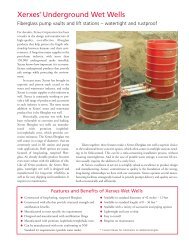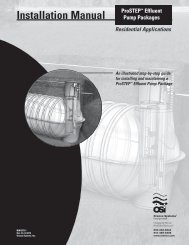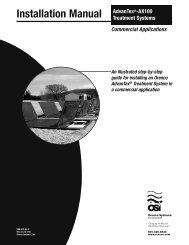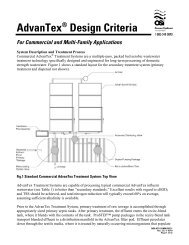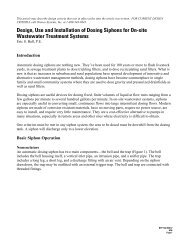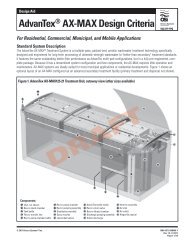Decentralized Wastewater Cluster Management: Operation and ...
Decentralized Wastewater Cluster Management: Operation and ...
Decentralized Wastewater Cluster Management: Operation and ...
Create successful ePaper yourself
Turn your PDF publications into a flip-book with our unique Google optimized e-Paper software.
DECENTRALIZED WASTEWATER CLUSTER MANAGEMENT: OPERATION ANDMAINTENANCE EXPERIENCE AND COSTSKevin D. White, Ph.D., P.E.University of South AlabamaDepartment of Civil EngineeringMobile, AL 36688ABSTRACTIn Mobile, Alabama, 12 public utility-managed decentralized wastewater cluster systems havebeen implemented over the past four <strong>and</strong> one-half years. New suburban development is pushingwest from the city, into unsewered watersheds, including the watershed containing J.B. ConverseReservoir, the city’s drinking water source. Traditionally, wastewater management in thesedeveloping areas has consisted of traditional onsite treatment (septic tanks <strong>and</strong> dispersal fields),but with new l<strong>and</strong>-development pressure, the developers desire for more marketable (sewered)properties, <strong>and</strong> some history of onsite system failures, decentralized cluster systems serving 90 to270 homes each have been implemented by three separate utilities. The decentralized clustersystems consist of small-diameter effluent sewer (septic tank effluent pump (STEP) or gravity(STEG) collection), recirculating packed bed treatment, <strong>and</strong> in-ground effluent dispersal orreuse. The management models being used in Mobile are most closely aligned with EPA’smanagement level 5—utility ownership <strong>and</strong> maintenance of the entire system. Financing of thesystems total capital cost ($7500-$8000 per home) consists of some form of developerparticipation in up-front costs (equity investment <strong>and</strong>/or tap fees) <strong>and</strong> capital recovery fromsewer fees. Individual homeowners pay a $35-$40 per month sewer fee for comprehensivesewer service. To date, the operation of these small-diameter effluent sewers <strong>and</strong> packed bedtreatment systems has been quite efficient <strong>and</strong> maintenance activity minimal. <strong>Operation</strong> <strong>and</strong>maintenance costs for cluster systems serving 100 homes range from $8000 to $15,000 per year.KEYWORDS<strong>Decentralized</strong> management, capital costs, utility ownership, cluster management, new utilitymanagement systemsINTRODUCTIONHistorically, since 1972 when the Clean Water Act was enacted, municipalities in the U.S. haveused Federal funds to construct sewers <strong>and</strong> centralized treatment plants to meet nationalst<strong>and</strong>ards for the discharge of pollutants to surface waters (USEPA, 1997). Lewis (1986)estimated that over $62 billion of government funds have been spent on centralized sewersystems in the U.S. from 1972 to 1990. More recently, grant funding has been replaced bycompetitive, low-interest loans called Clean Water State Revolving Fund (SRF) programs <strong>and</strong>bond programs. Although the centralized treatment model has been quite successful from the1682
treatment st<strong>and</strong>point (treated effluent quality is consistently good <strong>and</strong> stream quality hasdramatically improved since the 1970’s), collection system problems (infiltration <strong>and</strong> inflow),capacity issues (sewer overflows <strong>and</strong> plant by-passes), biosolids h<strong>and</strong>ling, <strong>and</strong> costs are stillmajor issues. And, we are no closer today to the Clean Water Act goal of “ZERODISCHARGE” than we were 30 years ago.<strong>Decentralized</strong> wastewater management is typically defined as the collection, treatment, <strong>and</strong>disposal/reuse of wastewater at or near the point of wastewater generation (Crites <strong>and</strong>Tchobanoglous, 1998). This includes both individual onsite wastewater management systems(septic tanks <strong>and</strong> in-ground dispersal fields) <strong>and</strong> cluster systems where some relatively smallnumber of dwellings (two to several hundred) are serviced together with a common collection,treatment, <strong>and</strong> effluent disposal/reuse. In many cases, because of the smaller flows h<strong>and</strong>led in adecentralized cluster system, alternative collection, treatment, <strong>and</strong> disposal/reuse systems can beemployed—many of which can be quite cost effective. Pretreatment, small-diameter sewer(effluent, gravity, pressure, or vacuum), recirculating media filters (s<strong>and</strong>, textile, etc.) or smallactivated sludge systems (extended aeration), <strong>and</strong> common in-ground dispersal trenches or dripirrigation can all be used in appropriate situations to minimize costs <strong>and</strong> address specific needs.The scale of the wastewater system significantly affects the size <strong>and</strong> cost of capacity additions toa system (Rocky Mountain Institute, 2004). Centralized systems tend to be build in a few largephases, with an incorporation of extra capacity to accommodate future growth. <strong>Decentralized</strong>cluster systems allow for smaller, more frequent increments of capacity to be built, so as tocloser accommodate actual needs.The costs of providing <strong>and</strong> maintaining appropriate wastewater management infrastructure formost municipalities employing centralized sewer are enormous. The 2002 EPA Needs Surveyestimated that U.S. wastewater infrastructure needs approach $500 billion over the next 20 years.Either government subsidies will be utilized to provide this need or sewer rates to the typicalhomeowner will rise significantly.Cost is a key factor in selecting wastewater management options for any community. The costof these options depends on specific community characteristics, such as population, populationdensity, topography, <strong>and</strong> desired effluent quality. It is also interesting to note that much of thenew l<strong>and</strong> development (commercial <strong>and</strong> residential) occurs just outside the existing urbansewered areas in what the USEPA defines an urban “fringe”. These areas tend to be within 10miles of the sewered city. Other areas commonly developed are properties along waterfronts(rivers, lakes, bays, oceans, etc.), which in many cases does not have sewer availability.Environmental (<strong>and</strong> public health) protection in these areas along waterfronts is criticallyimportant.USEPA Cost Analysis of <strong>Decentralized</strong> <strong>Cluster</strong> SystemsUSEPA (1997) compared the costs for different wastewater management options (centralized vs.decentralized cluster) for two hypothetical communities—rural <strong>and</strong> fringe. The fringecommunity described is outside the conventionally sewered city system <strong>and</strong> best describes the1683
most common decentralized cluster wastewater model seen in the Mobile, Alabama area <strong>and</strong> sowill be described further.The fringe community, as described by USEPA, is located 10 miles from the nearest city (<strong>and</strong> itsconventional sewer) <strong>and</strong> was evaluated based on an expected future population of 1550 peopleliving in 443 homes on one-half acre lots. <strong>Wastewater</strong> options evaluated by USEPA for thefringe community consisted of:Centralized option 1 – A new conventional gravity collection system connected to anexisting centralized treatment facility that currently serves the main municipality. The existingsystem has adequate collection <strong>and</strong> treatment capacity. Treatment is accomplished viasequencing batch reactor (SBR) with grit removal, screening, disinfection, <strong>and</strong> sludge disposal.Centralized option 2 – A new conventional gravity collection system connected to anexisting centralized treatment facility that currently serves the main municipality. The existingsewers have adequate capacity but additional treatment capacity is required. Treatment isaccomplished as described above in centralized option 1.<strong>Decentralized</strong> cluster option – New alternative collection (small diameter gravity sewers<strong>and</strong> construction of new small cluster treatment systems, each consisting of s<strong>and</strong> filters <strong>and</strong> acommon leach field. New homes required the installation of a new septic tank which connects tothe small diameter sewer.Cost summaries (table 1) include the capital costs necessary to install the system(s) <strong>and</strong> theannual costs to operate <strong>and</strong> maintain the system(s). Capital costs were annualized over a 30 yearlife using an annual discount rate of 7%.Table 1. <strong>Wastewater</strong> <strong>Management</strong> Options for Fringe Communities (USEPA, 1997).WW <strong>Management</strong> OptionCentralized Option #1@ 1 mi. from existing sewer@ 5 mi. from existing sewerCentralized Option #2@ 1 mi. from existing sewer@ 5 mi. from existing sewerTotal Capital Cost1995 $$3,322,900$5,377,800Annual O&M Cost1995 $$83,800$95,900Total Annual Cost1995 $$351,600$529,300$3,786,900 $83,800$389,000$5,841,800 $95,900$566,700<strong>Decentralized</strong> <strong>Cluster</strong> $3,783,700 $18,000 $322,900Table 1 shows that the decentralized option is the least expensive option from the totalannualized cost perspective in this type of fringe community. It is particularly the most costeffectiveoption when the fringe community is greater than 5 miles from a sewer interceptor orwhere the existing collection or treatment facilities require upgrading. The decentralized optionexhibits much lower operation <strong>and</strong> maintenance costs. Long-term growth <strong>and</strong> the assimilative1684
capacity of the receiving environment may also be factors in choosing the centralized ordecentralized options. Because the centralized option typically concentrates all wastewaterdischarge at one location, the relative costs of failure for centralized systems can be far greater.An as watershed Total Maximum Daily Loads (TMDLs) become more enforceable, thedecentralized wastewater management option may become more desireable.DECENTRALIZED WASTEWATER MANAGEMENT IN MOBILE, ALABAMAMobile, Alabama (pop. 240,000) is situated on the western shore of Mobile Bay, just north of theGulf of Mexico. For the past several years, new residential development has been located westof the city, outside of the urban sewered Mobile Bay watershed. Because of variable soilconditions <strong>and</strong> high groundwater tables, conventional onsite wastewater systems (septic tanks<strong>and</strong> dispersal fields) have experienced a rather high failure rate (~25%). Developers <strong>and</strong>homebuilders tend to be held liable for onsite wastewater system performance, certainly for thefirst several years of occupancy. This liability can be both time consuming <strong>and</strong> costly for adeveloper, not to mention the reputational damage this may incur.Beginning in about 1999, discussions between local developers, the Mobile County SchoolBoard, <strong>and</strong> the Mobile Area Water <strong>and</strong> Sewer System (MAWSS) led to the design <strong>and</strong>implementation of the first decentralized cluster system in the area—located at newlyconstructed Nora Mae Hutchens Elementary School . MAWSS is the large, urban water <strong>and</strong>sewer provider in Mobile <strong>and</strong> needed a way to provide sewer service to new development inunsewered watersheds west of the city. The Hutchens wastewater facility became operational inDecember 2000, <strong>and</strong> serves a large elementary school, <strong>and</strong> about 100 homes in the area. Today,in 2005, there are 12 decentralized cluster systems operational in Mobile County, Alabama,operated by 3 different public utilities—MAWSS, South Alabama Utilities, <strong>and</strong> Gr<strong>and</strong> BayUtilities. South Alabama Utilities, prior to 2000, had been a rural water <strong>and</strong> gas provider inMobile County, with very little, wastewater experience. Gr<strong>and</strong> Bay Utilities had no wastewaterexperience prior to 2001. The 12 systems now in operation range in capacity from 10,000 gpd(45-50 equivalent dwelling units-EDUs) to 60,000 gpd (270 – 300 EDUs).<strong>Decentralized</strong> <strong>Cluster</strong> DesignsIn Mobile, all three management utilities are using effluent sewer for collection, recirculatingpacked-bed (or attached growth) treatment systems, <strong>and</strong> some form of in-ground dispersal/reuse.Effluent sewers are used for collection. The septic tank effluent pump (STEP) collection systemis a cost-effective alternative. In this collection system, a septic tank at each residence collectsraw wastewater <strong>and</strong> settles solids. The liquid effluent (without solids) can then be pumpedthrough a small diameter (2" to 4") PVC pressure line to the treatment unit. High head, stainlesssteel effluent pumps (½ hp, 10 gpm), housed within an effluent filter, offer long life <strong>and</strong>reliability (low O&M). This type of collection system offers several advantages:1. Solids are collected in the septic tank, liquefy over time, <strong>and</strong> thus do not figure into thetreatment component of the system. This results in a reduced wastewater strength (see1685
table 2). Treatment is subsequently less complex (<strong>and</strong> less costly) <strong>and</strong> operation of thetreatment system is simpler. In fact, because of lower organic loading to the treatmentsystem, biosolids production (<strong>and</strong> solids h<strong>and</strong>ling at the treatment plant) is minimized.2. Small diameter, solvent-welded PVC collection lines (without manholes) significantlyminimize infiltration <strong>and</strong> inflow (I & I) that larger diameter conventional gravity sewerscannot.3. Solids management (sludge pumping from the septic tank) occurs infrequently (every 4to 7 years), thus minimizing management. The schedule for sludge pumping is controlled<strong>and</strong> performed by the managing authority. Monthly sewer fees (on the utility bill) coverthis infrequent cost.4. <strong>Wastewater</strong> pumping costs (pump electricity) are borne by the homeowner(approximately $2.00 per month on the power bill).5. Small diameter PVC installation costs are significantly lower than conventionalsewer line installation ($5-$8 per foot versus $15 per foot or more forconventional sewer).6. Storage volume is built into the system to help buffer peak flows <strong>and</strong> to allow forsituations of short-term power outages.Table 2. Raw wastewater characteristics based on collection system type (Crites <strong>and</strong>Tchobanoglous, 1998).<strong>Wastewater</strong>CharacteristicsBODmg/LTSSmg/LFats, Oil, &Grease, mg/LEffluent Sewer ConventionalGravity SewerGrinder/VacuumSewerLow strength Full Strength Full Strength(liquids only) (liquids <strong>and</strong> solids) (slurry)100-150 200-450 300-45020-40 200-450 300-45010-20 50-150 60-160The decentralized cluster treatment systems being used in Mobile to date are either recirculatings<strong>and</strong> filters or recirculating textile media filters, both attached-growth, aerobic processescharacterized by relatively low organic loading rates (so as to minimize biosolids production).Effluent quality has typically achieved 10 mg/L BOD, 10 mg/L TSS, <strong>and</strong> 1.0 mg/L NH 3 -N. Thesystems are operated via two 3/4 horsepower turbine-type dosing pumps (30 to 50 gpm,depending on plant flow) located in the recirculation tank <strong>and</strong> one or two 3/4 horsepowereffluent dosing pumps (to supply the in-ground dispersal fields or the subsurface drip irrigation1686
zones). A control panel operates the system automatically, but can be accessed remotely viatelephone telemetry. The recirculation tank is usually sized to hold 1 to 1.25 times daily flow.These treatment systems are largely under ground so as to be unsightly, are quiet, exhibit verylow odors, are quite cost effective, <strong>and</strong> are relatively compact in size. A 60,000 gpd treatmentsystem (120,000 gpd peak) that can accommodate about 300 EDUs can be located in an area ofabout one-quarter acre.Treated effluent management typically employs some form of in-ground dispersal or reuse.Gravel seepage beds, chamber-type trenches, or subsurface drip irrigation have all been usedsuccessfully. In-ground dispersal requires an Underground Injection Control (UIC) permit fromthe State environmental protection agency. UIC required monitoring <strong>and</strong> reporting issignificantly less than that required for surface water discharges (governed by NPDES permits),<strong>and</strong> is thus less costly. Originally, when these systems were new to the State environmentalprotection agency, one composite effluent sample was required weekly; but now, after 3 years ofoperation, only one composite effluent sample is required per month. One groundwatermonitoring well, downgradient from the in-ground dispersal system, is required to be sampledonce per quarter (every 3 months).Experienced Capital CostsTotal capital costs for the decentralized cluster systems (pretreatment, collection, treatment, <strong>and</strong>in-ground dispersal/reuse) being used in Mobile have typically ranged from $7000 to $8500 perEDU. Based on a 100 EDU system (~20,000 gpd average flow), the total capital cost of thesystem can be implemented for $700,000 to $850,000. These costs are categorized as follows(again based on a 100 EDU system costing about $8000 per EDU):Onsite CostsSeptic tank, effluent filter <strong>and</strong> pump, control panelCollection System Costs2-inch PVC @ $6/linear foot, 120 feetTreatment/In-Ground Dispersal System CostsRecirculating textile media, chamber trenches$3300/EDU$ 720/EDU$3500/EDUEngineering$ 480/EDU12% of the treatment/dispersal system cost, plus------------------------ --------------Total Capital Costs$8000/EDU1687
<strong>Operation</strong> <strong>and</strong> MaintenanceThe proper operation of the decentralized cluster system requires power to operate the pumps(<strong>and</strong> vent fans if needed) at the treatment plant, personnel to oversee the system (providingroutine maintenance <strong>and</strong> needed repairs), to pay for monitoring of the effluent <strong>and</strong> groundwater,to manage solids accumulation in septic tanks every 5 to 7 years, <strong>and</strong> overhead funds to managepaperwork, bill, <strong>and</strong> respond to the consumer. O&M costs are summarized below.South Alabama UtilitiesSouth Alabama Utilities operates 6 decentralized cluster systems; either recirculating s<strong>and</strong> filters(RSF) or recirculating textile media filters (RTM) in various stages of build-out capacity (DonnieCunningham, personal communication, 2005):Facility Technology Capacity Actual FlowLott Road RSF/trenches 10,000 gpd 10,000 gpd HarmonyRidge RTM/drip 30,000 gpd 2,650 gpdOaks @ Westlake RTM/trenches 22,000 gpd 9,800 gpdChampion Hills RTM/trenches 30,000 gpd 6,275 gpdWindy Oaks RTM/trenches 30,000 gpd 800 gpdTurner School RTM/trenches 20,000 gpd 8,659 gpd<strong>Operation</strong> costs per treatment plant are classified into the following categories:A. Power. $1440/year.Average power cost to operate a treatment system, using two 3/4 horsepowerturbine pumps in the recirculation tank <strong>and</strong> one 3/4 horsepower pump in the effluentdosing tank <strong>and</strong> two vent fans, is $120/month ($1440/year). This works out to be about$33/month per pump <strong>and</strong> $7/month per vent fan. It is recognized that the facilities arenot operating at design flow, however, pump runs are set on time <strong>and</strong> so would notnecessarily increase in proportion to increased flows.B. Personnel. $42091. Routine site visits. A single technician visits each treatment plant 3 times perweek, spending 20 minutes each visit to record flow, verify proper operation (pump runtime), <strong>and</strong> effluent dosing performance. Using a $30/hour wage <strong>and</strong> 4.5 weeks permonth, this cost is $135/month ($1620/year).2. Routine effluent filter cleaning. Once every 2 months, a technical will spendan hour to remove <strong>and</strong> clean the effluent filter in the recirculation tank, costing about$15/month ($180/year).3. Site maintenance. Grass cutting around the site occurs about twice per month<strong>and</strong> takes 1.5 hours each occurrence. A technician making $20/hour spends 3 hours permonth, costing $60/month (9 months per year or $540/year).4. Septic tank inspections. Each tank in the system is inspected once every twoyears, taking about 30 minutes per tank. Inspecting half of the septic tanks per year (501688
tanks in a 100 EDU system) would take 25 hours. An inspector making $30/hour wouldcost $750/year.5. Miscellaneous repair. In 3 years of operating decentralized systems, 1 pumpreplacement/repair has been documented ([6 hours x $30/hr] + $125 electrician fee =$305) at a cost of $102/year. Four float repairs have been made in 3 years ($407/year).Six building connection repairs (electrical/mechanical) have been made in 3 years($610/year).C. Monitoring. $2149/year.1. Effluent composite. Sampled once per month for BOD, TSS, ammonia, <strong>and</strong>pH at a cost of $115/month ($1380/year).2. Ground water well. Sampled once every 3 months for BOD, TSS, ammonia,nitrate, <strong>and</strong> pH at a cost of $190 ($760/year).D. Septic Tank Pumping. $3400/year.Eventually, inert solids will build up in the individual septic tanks <strong>and</strong> pumping ofthese solids will become necessary. On a 6 year cycle, about 17 tanks (out of 100EDU) will need pumping in a given year. Using a pumping cost of $200/tank,pumping will cost $3400/year.E. Overhead Costs.Using an overhead rate of 40% to cover billing, paperwork, permit compliancereports, etc., overhead costs are estimated to be $4479/year.Total annual operation <strong>and</strong> maintenance costs are thus estimated to be $15,677. This is justslightly less than the $18,000/year (1995 dollars) O&M cost estimated by USEPA (1997) for asomewhat larger system (443 homes).Mobile Area Water <strong>and</strong> Sewer System (MAWSS)MAWSS is currently operating 4 decentralized cluster treatment systems, similar in design <strong>and</strong>operation to those operated by South Alabama Utilities.Facility Technology Capacity Actual FlowHutchens RSF/trenches 60,000 gpd 26,000 gpd Copel<strong>and</strong>Isl<strong>and</strong> RSF/beds 50,000 gpd 24,000 gpdSnow Road RTM/beds 20,000 gpd 7,500 gpdHamilton Oaks RTM/beds 20,000 gpd 7,000 gpd<strong>Operation</strong> <strong>and</strong> maintenance activity experienced by MAWSS has been similar to thatexperienced by South Alabama Utilities. One technician oversees all of the four MAWSSdecentralized cluster systems <strong>and</strong> visits each facility a couple of times per week. All of thetreatment facilities are remotely connected via SCADA telemetry.MAWSS provided all O&M cost data expended on the 4 decentralized treatment systems for the2004 calendar year (Mark Lowery, personal communication, 2005). Total O&M expenditures1689
were about $66,000, which works out to be an average of $16,480 per treatment facility. This isvery similar to the costs calculated for South Alabama Utilities ($15,677 per treatment system),as described above.These total O&M costs experienced by MAWSS can be broken down generally as follows:Personnel costs: $29,530UtilitiesElectricity $ 5,155Gas $ 467Water, etc. $ 146Repairs, Equipment, Services $15,472Analytical Testing $ 1,659Operating Supplies, Parts $13,571Note that personnel costs include pension contributions, health <strong>and</strong> life insurance contributions,overtime, FICA payroll taxes, etc. that are covered in the overhead category for South AlabamaUtilities.Orenco Systems, Inc.Orenco Systems, Inc. is an equipment supplier for recirculating s<strong>and</strong> filter treatment systems,recirculating textile media treatment systems, <strong>and</strong> effluent filters <strong>and</strong> pumping equipment usedcommonly in decentralized cluster system applications nationwide. <strong>Operation</strong> <strong>and</strong> maintenancecost data was obtained from Orenco (Mike Saunders, personal communication, 2005) fordecentralized cluster systems nationally.Orenco calculates O&M costs for collection <strong>and</strong> treatment separately. Personnel costs are basedon a $40/hour wage <strong>and</strong> the example uses 100 connections (EDUs). Power costs are based on$0.08/kwh <strong>and</strong> a phone line at $50/month. The treatment system O&M costs are calculatedusing a recirculating textile media filter system designed to serve 100 homes (20,000 gpdaverage flow), using 8 textile media pods.Collection System (effluent sewer) Maintenance $3,200/year- Proactive ($32/year per EDU)- Reactive ($2.67/month per EDU)Collection System <strong>Operation</strong>$6,700/year- Tank pumping ($67/year per EDU)- Equipment replacement ($5.58/year per EDU)Total Collection System O&M$9,900/year ($8.25/month per EDU)1690
Textile Media Component <strong>and</strong> System Maintenance $7,830/year- Pumps, filters, valves, vent fans, etc.- Solids inspection, flushing laterals, records, etc.Textile Media System <strong>Operation</strong> <strong>and</strong> Maintenance- Power (electricity)- Telephone lineTotal Textile Media O&M$1,960/year$9,790/year ($8.16/month per EDU)Total Collection <strong>and</strong> Treatment O&M$19,690/yearSUMMARYThe costs to operate <strong>and</strong> maintain decentralized wastewater cluster systems are quite reasonable.O&M cost data from two utilities in Mobile, Alabama who are operating several decentralizedfacilities is very similar to USEPA estimates prepared several years ago <strong>and</strong> O&M estimatescompiled by a national decentralized wastewater equipment supplier. Annual O&M costs forcollection/treatment systems serving 100 connections (EDUs) range from $15,677 per year(South Alabama Utilities) to $19,690 per year (Orenco Systems, Inc.). These O&M costs workout to be less than $17.00 per month per connection (EDU).ACKNOWLEDGEMENTSThanks to Mobile Area Water <strong>and</strong> Sewer System (Mark Lowery), South Alabama Utilities(Donnie Cunningham), <strong>and</strong> Orenco Systems, Inc. (Mike Saunders) for supply cost data <strong>and</strong>O&M activities.REFERENCESCrites, R.; Tchobanoglous, G. (1998) Small <strong>and</strong> <strong>Decentralized</strong> <strong>Wastewater</strong> <strong>Management</strong>Systems, WCB McGraw-Hill.Cunningham, Donnie (2005) personal communication, South Alabama Utilities.Lowery, Mark (2005) personal communication, Mobile Area Water <strong>and</strong> Sewer System.Rocky Mountain Institute (2004) Case Studies of Economic Analysis <strong>and</strong> Community DecisionMaking for <strong>Decentralized</strong> <strong>Wastewater</strong> Systems, National <strong>Decentralized</strong> Water ResourcesCapacity Development Project.Saunders, Mike (2005) personal communication, Orenco Systems, Inc.1691
USEPA (1997) Response to Congress on Use of <strong>Decentralized</strong> <strong>Wastewater</strong> Treatment Systems,Office of Water, Office of <strong>Wastewater</strong> <strong>Management</strong>, EPA 832-R-97-001b.1692


